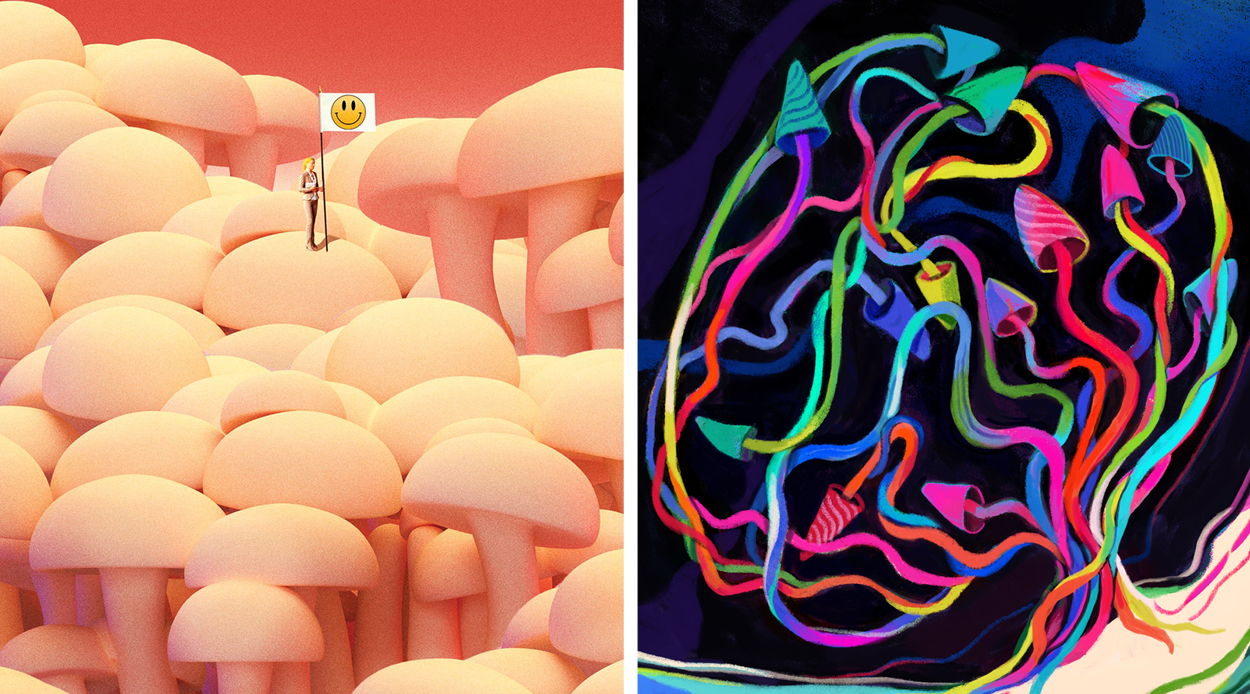Few of us are strangers to the connotations of hallucinogens — drugs grounded in a Woodstock-esque vision of the late 60s. Unfortunately, it is a prejudice that has stuck. Yet since the turn of the 20th Century, we’ve been growing a collective awareness of their application in therapeutic use, with Australia recently announcing changes to laws that allow the use of hallucinogens in therapeutic sessions (administered by a psychiatrist), becoming the first country in the world to do so. As such, many in the field are now predicting New Zealand will follow suit, ushering in a new era of drug-induced psychedelic therapy. From this vantage point, the prospect of change is finally promising.
In understanding the therapeutic application of illegal psychedelics, it is easiest to define what it is not. It is not decriminalising or legalising a drug for recreational use, and it won’t be made any more widely available on the streets than it currently is (which, if you’re curious, is actually a lot). It is not to be confused with microdosing either — which shouldn’t be discredited as it still has a relevant role to play in therapeutic use too.

Microdosing, in theory, is concerned with small, regulated doses over a sustained period, allowing the user to tap into their inner creative self, a lessened sense of self-judgement and anxiety, and an unbridled sense of freedom, supposedly. Its use has also been critical in aiding recovery from some mental health conditions (although not those that can be triggered by drug usage, such as schizophrenia and bipolar disorder). Done right, it’s subtle. There are no clichéd visualisations and hallucinations. For most, it just makes approaching the challenges of daily life a little more manageable.
Therapeutic application, in contrast, argues the case for macrodosing. The goal here is to succumb to a trip in all manners imaginable. Experts will often argue that it is the trip, rather than the drug itself, which triggers the most profound shifts. In disconnecting with reality, even only momentarily, there is room for ego dissolution and that is where, I’m told, the most profound, lasting shifts happen. It is this return to our primal human nature, best likened to a rebirth in many senses, that prompts a greater sense of freedom, a connection to a higher purpose and an intrinsic understanding of the world. Some have described it as a religious experience.
What’s In A Trip?
For those who have yet to experience a trip, there are a few things one can compare it to, and very rarely is it ever the same. One obvious factor is the stimulant you’re taking; as LSD (acid) differs from the kind of trip one would anticipate with psilocybin (the compound in magic mushrooms). Even then, the experience of tripping itself is difficult to articulate, other than to say that it alters perception and is extremely transformative. Many find the world becomes a kaleidoscope of colours and patterns, and ordinary objects take on new and profound meaning. Time feels like it stretches and warps, and the self dissolves into a sense of oneness with everything. It’s almost as if the world as you know it begins to melt away.
The experience can be both beautiful and terrifying, as the mind is opened to new possibilities and perceptions that were previously unimaginable. It is a journey into the unknown, a leap of faith that requires surrender to the moment and trust in one’s self. Ultimately, the trip is a reminder that reality is not fixed, but rather a fluid and ever-changing state of being that is ripe for exploration and discovery.
And so, with that same goal, therapeutic use hopes to remove the connotations of a trip as something associated with recreational drugs.
It is less so about the experience as a social one (despite it often being anything but) and more so about recognising the benefits of a clinically-induced trip as a legitimate approach to psychotherapy treatments. In another sense, it’s a rebuttal to the ‘War on Drugs’, which has seen the adoption of these treatments sidelined due to ongoing misinformation and political agendas. Through seemingly endless studies, psychedelics like LSD and magic mushrooms have been found to alleviate symptoms of anxiety, depression, alcoholism, and PTSD by shifting patients’ perspectives and fostering a greater sense of connection, both to themselves, and to the world.

Additionally, these drugs offer potential for increased creativity, empathy and compassion, as well as inducing a profound sense of wonder and spiritual growth. The experience of a drug trip can help to break down limiting thought patterns and create new perspectives. It can also enhance creativity and problem-solving abilities. By opening up the mind to new perspectives and experiences, these hallucinogens hold the potential to unlock the power of the human psyche and provide a deeper appreciation for life, making them perhaps the best-suited solution to treatment-resistant mental health disorders.
But coming back to the age-old adage of any drug use — safety measures are paramount (one should be warned against an urge to order DMT on the dark web and simply hope for the best). When losing inhibition and control, the environment is so integral, as is the actual makeup of what you’re taking. In-clinic therapeutic use is widely regarded as the best way to easily monitor an individual and regulate the substances taken, so that benefits can be experienced as they were meant to. The concept is almost trivial in theory, but in Australia, it is poised to change the landscape entirely.
Late last year, the Therapeutic Goods Administration (TGA) gave the green light to psychedelics for therapeutic purposes, a groundbreaking decision that makes Australia the first country to do so. The use
of hallucinogens MDMA and psilocybin will be closely controlled by psychiatrists, and will only be prescribed for certain mental health conditions such as post-traumatic stress disorder and treatment-resistant depression.
A recognition of the limitations of current treatments for these conditions and the potential benefits that these drugs could bring, mark a significant moment in the evolution of medicine, and one that will undoubtedly provoke controversy and debate.
While the number of eligible patients remains unclear, psychiatrists must be approved by a human research ethics committee and the TGA’s authorised prescriber scheme to be able to use these medicinal psychedelics. These drugs can only be obtained via importation under a TGA licence for the time being. Nevertheless, the CSIRO is teaming up with Australian firms to develop new psychedelic medications and improved manufacturing techniques for local production. To guide the use of these medicines, a series of psychotherapy procedures, protocols and training plans will be formulated in the weeks and months to come. And while specific patient treatment protocols are still in the works, psychotherapy is deemed the most crucial part of the treatment — meaning it’s not an opportunity for a quick fix (you can’t just hop on a plane to Sydney for a legalised trip), but rather an essential part of a lengthy process.
Psychedelic Therapy in New Zealand: Hallucinogens On Home Soil
Currently in New Zealand, hallucinogenic use remains illegal in every sense — despite many groundbreaking studies on psychedelic therapy being conducted through leading researchers at our universities. Dr Suresh Muthukumaraswamy is one such researcher, whose recent study through the University of Auckland considers the impacts of LSD (otherwise known as acid) on mood and function. In 2020, over a period of six weeks, he monitored a test group microdosing the drug, and noted an overall improvement in mood across the board. This time, he hopes to observe the effects on those with an already lowered mood, (namely treatment- resistant major depressive disorder), and examine whether it has an antidepressant effect. Being in the realm of research, the study is able to side- step the recreational legalities and access quality, tested LSD, but not without seemingly endless red tape, background checks and rigorous protocols. It is an arduous task in the name of increasing our understanding of science, and as we’ve found in the case of Australia, it is still challenging for practitioners to get their hands on, even when it is legal. But with the rising rate of mental health conditions, this kind of research is paramount.

“There are a lot of patients out there with mental health issues and patients with depression who either don’t like the medicines that they’re on, or the medicines that they get prescribed don’t work for them. So they need more options, that’s become pretty clear,” Dr Muthukumaraswamy reasons. But concerns surrounding legalities still remain locally, and there is a certain degree of cognitive dissonance that exists within the realm of recreational hallucinogens. When talking about the therapeutic benefits, or even simply considering the substances as party drugs, the societal implications are often thrown by the wayside, with little regard to the people they impact the most.
Let me be very clear — anyone found in the possession of these substances (magic mushrooms and LSD [acid] are both currently Class A) can lead to six months incarceration, and/or up to a $1000 fine. Anyone involved in the production of these can face life imprisonment (which in New Zealand, carries a maximum term of 17 years). MDMA, the other hallucinogen legalised in Australia for therapeutic use, carries a slightly smaller sentence as a Class B drug. So while it is essential we mention the benefits of these psychedelics, it is also vital to note that under the 1975 Misuse of Drugs Act (legislation that many experts believe to be outdated) usage is still a serious offence, no matter how earnest your intentions. Without legislation created for therapeutic use, it is likely the supplier will face the shortfall for the freedoms of others.
On Innovation & Investment
With decriminalisation and legalisation only predicted to further boom in the way of hallucinogenics, an opportunity to remain ahead of the curve presents itself. There is room for innovation on a mass scale, in the way of direct-to-consumer products (albeit slightly more hopeful) like Layer, a concept for an edibles subscription service delivering sweets and teas laced with tried and tested doses of psychedelics intended for microdosing. Thinking more largely, room exists within the medical field too. As Stephen Bright, director of Psychedelic Research in Science and Medicine told The Sydney Morning Herald, “there are no products available, and aside from myself and a handful of colleagues, there’s no one trained to provide the treatment.” Those with an eye for innovation should recognise the immense need for supply — as while regulations remain a challenge, a time will soon come when these services will be in high demand.

As The Wall Street Journal indicates, one of the next financial sub-sectors to boom is psychedelic medicine, where Venture Capital firms like Empath Ventures are investing exclusively in
start-ups that sit within this realm — and those that are predicted to bring profit to the budding market. Founder Brom Rector likens it to crypto, the industry in which he found his success, telling WSJ, “psychedelics is similar to crypto in the sense that it is a crazy big sort of bold new investment thing.” Like any industry, it is a guaranteed risk, but one that only stands to evolve and expand exponentially in the coming years.
In the twilight of the twentieth century, this new chapter has been written in the realm of therapeutic medicine. Yet until now, it has only existed as a realm of discovery and research, and so the changes to legislation over the Tasman are poised to usher in a new era of psychedelic therapy for New Zealand — one for which, the many struggling with treatment-resistant depression, anxiety, PTSD and even alcoholism have spent their lives waiting. It is a considered (and supervised) use that can be used for deep and lasting transformation, and hopefully, will see decades of stereotypes passed over in the pursuit of healing humankind.







